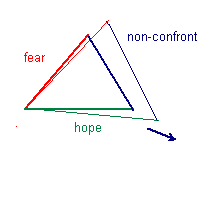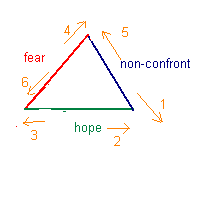

You've probably guessed it by now: yes, it's Charlie Churchmouse III. Jr., who just got evicted from the Chapel down the road because of indecent behavior (I'll spare you the grizzly details here).
Now, Timmy D. could just simply kick Charlie out of the closet and that would have been it. But it's 2 o'clock in the morning and Timmy D. has a much better solution: Timmy just waits it out and hopes that Charlie would go away by himself.
The next morning Timmy D. doesn't get the warm fur coat out of the closet, just in case Charlie is still around. After all, spring is here and the temperature just went up by more than 20 degrees Fahrenheit and is nearly over 30 already and there was no blizzard warning on the Weather Channel last night and a light jacket is good enough anyway since it's only a twentyfive minute walk to work.
Later on that day,
Timmy D. comes down with a cold and stays in bed for two days. Meanwhile,
the notorious Charlie Churchmouse III. Jr. met the beautiful mouse lady
from the trashcan next door. She's a simple housemouse and under normal
circumstances he wouldn't settle for anyone who is not
of noble descent like
himself. But he wants to start a new life and forget his ugly past. So,
what the heck, she's great looking - let's party, he thinks, and she's
convinced that the rumors about him aren't true, people exaggerate all
the time, and even if the rumors would be true, he would certainly change
his wicked ways once
they would have a little family together with a dozen or two cute mousekids.
Besides, Charlie just moved in this huge mansion with a giant fur hanging down from the ceiling. Even if things wouldn't work out, she was sure, she would get the mansion and at least part of the fur if they should ever get divorced.
(To make a long and complicated story short, they married overnite in Mouse-Vegas and started immediately to work on their offspring which is, of course, a responsible and hard and noisy task.)
Timmy D., waking up from the noise of Charlie's family planning efforts in Timmy's closet, now feels that all the hopes that he would disappear was in vain, and the feeling of fear starts creeping into Timmy's mind that Charlie would be there dancing in the closet whenever the door would be opened.
For brevity's sake,
I have to shorten this story here. Suffice to say that after a while Charlie
got divorced from the beautiful housemouse after she found out that he
was fooling around with her
equally beautiful
sister who had been baby-sitting her 29 beautiful children. Charlie
had to give up the mansion and even had to leave most of the fur in there
because his new place, across
the hallway in the
oak bathroom cabinett did not accommodate that much furniture.
Timmy D.'s Health Insurance officer finally approved a shrink to treat Timmy's phobia of opening any kind of doors and Timmy eventually moved to California because it never rains in California, all doors are open for a talent like Timmy, and there shouldn't be too many mice down there with all these rattlesnakes crawling around.
Now, this abbreviated and sad but true story has a pattern that can be traced in many other situation in life. It's the pattern of the 'Terrible Triangle' of non-confront, hope, and fear.
It all starts with a situation that a person is not willing or able to accept. In our example, a mouse in the closet.
Instead of acting on it, the person may choose to not confront the situation. As a pseudo-handling the person creates hope in its mind that the situation will handle itself over time.
This 'hope' is an emotion that the person is carrying around at all times and in 'present time'. This may come as a surprise because 'hope' is often thought of a solution in the future.
But the 'feeling of hope' happens in present time and blocks the person from looking at the non-confrontable things which it is now pushing into the past. It prevents the person also from acting whether immediately or in the future.
At the same time, fear arises that the non-confronted situation may arise in the future despite the hope. This now creates an implicite postulate that it will happen, sooner or later.
At the same time the original condition remains unchanged or even grows while the person is 'waiting' in a hypnotized and paralyzed state of mind without taking action:

On top, 'Fear' closes the circle which really is more like a triangle.
Fear can be described as the consideration that 'hope' didn't work out and something else will happen instead (see '1' in above picture.) Fear thus acts as a postulate that the condition that is being feared will realize in the future.
Hidden underneath the fear there is always a piece of hope that something non-confrontable will change or not occur (cp. '2'). For practical purposes this means that any fear can be alleviated by finding and resolving the matching 'hope'.
Thus, underneath
hope lures something that the person cannot confront ('3').
(Again, for practical
purposes fear can be diminuished by raising the level of confront.)
All this forms a classic triad which can be modelled as a triangle. Everytime one side, whether non-confront, hope, or fear, changes, two other sides are changing, too:

Looking at the forces
in play, a self-reenforcing structure with
push- and pull vectors
becomes visible:

The slightest increase in any of the three sides of the triangle will result in an increase of the other sides.
Now, fortunately it also works the other way around: if confront is increased, fear will be diminuished and there is not much need for hope anymore. In any case, all three sides would have to be eliminated in order to prevent that the triangle resurrects itself from the ashes of one or more remaining sides.
Unfortunately, by that time there may be already entities attached to either side of the triangle. This entity may have cloned itself may persist in time independently of the original triangle.
Which means that
there are two tasks at hand:
One technique will be briefly summarized here because it demonstrates the triangle model, the ancient (and still widely used) method of 'complete surrender':
in this 'techniques', whichever way it is being brought about, the person gives up all resistance to the condition that was rejected, in our example, the mouse in the closet.
Now that the condition itself has become accepted, the triangle can be entered again and resolved or weakened.
This will usually require a considerable amount of courage to override the fear and the non-confront. It will also require a great amount of trust because the person has to give up any and all 'hope' mechanisms and put their trust solely into the process (or into a God-like entity that has been associated with the process in its beginning).
This process can indeed break the vicious 'cycle' of the terrible triangle in many cases.
'Modern' technologies, especially NLP and Transformational Processing, have an arsenal of weapons to work on that triangle. Weapons that work a lot smoother and more predictable than 'complete surrender'.
It should not go unnoticed that hope is a central piece for many personalities with which they may uncritically identify. 'Taking away their hopes' may be a threatening proposal to them and it raises the ethical question to which degree the 'Terrible Triangle' should be resolved with the help of a facilitator.
The viewpoint that it is more important to know and understand the mechanisms of creation of aberrations rather than the undoing of already created ones is a premise of Gotamo (the 'Buddha'). This view is comparable to preventive healing rather than fixing symptoms.
In any case, there
certainly would be hard times ahead for the likes of Charlie Churchmouse
III. Jr. if more people would do something about their fears instead
of hoping that one day these fears would go away (huuh, what a nice self-reflexivity!)...